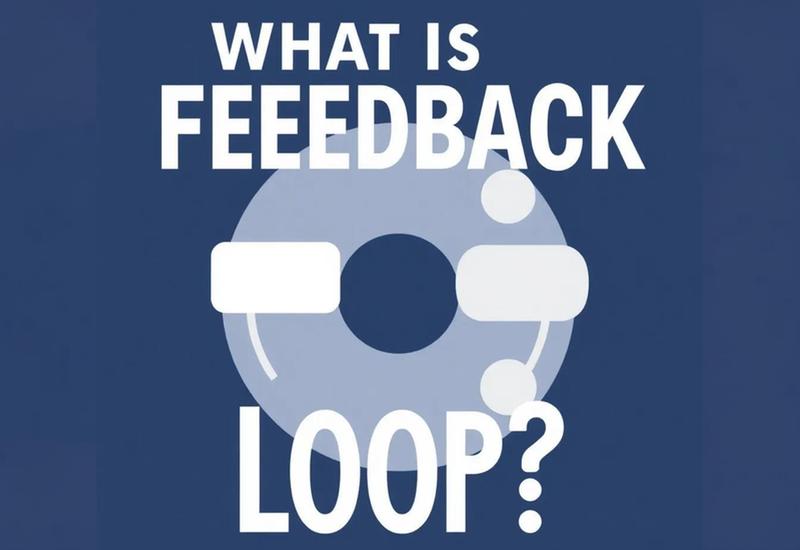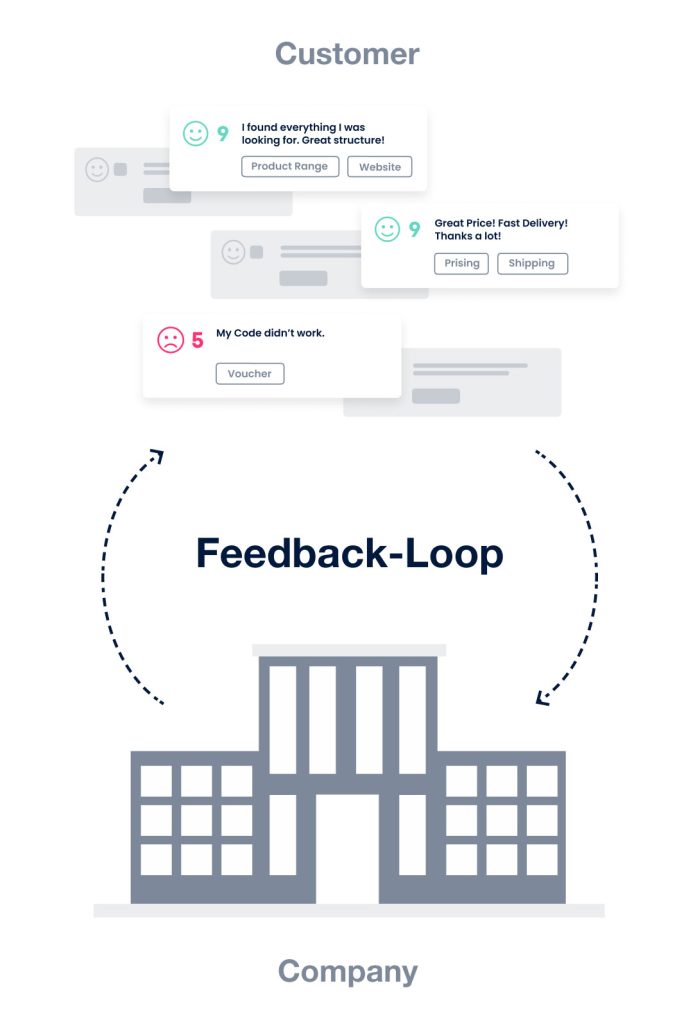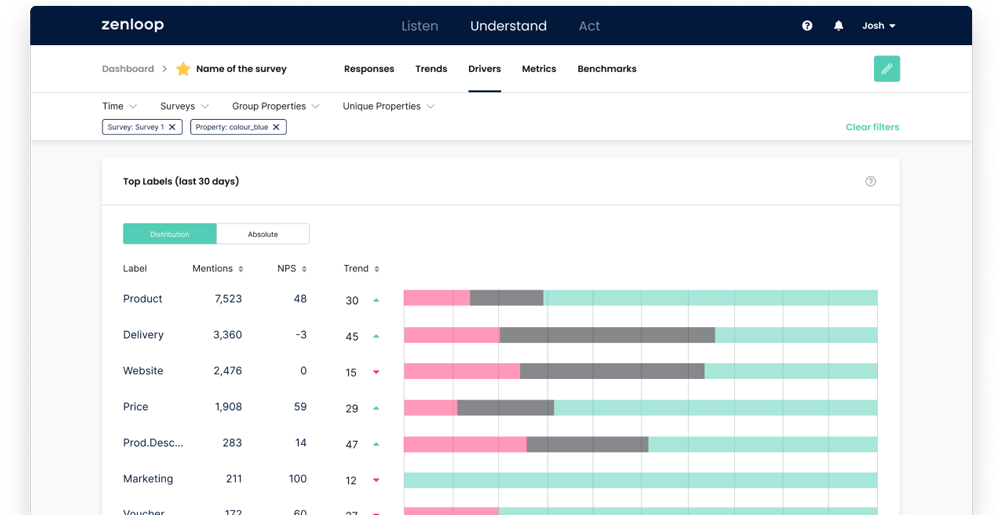Feedback Loops
How Customer Feedback Can Increase Business Success
Feedback loops are an important marketing tool for strengthening customer loyalty. What may sound innovative and technical at first is based on a principle that is almost as old as the Earth itself. Without feedback loops, there would be no people, nor the ability to read this article on the Internet right now. Feedback loops can be found in all areas of our lives and control our technical, biological, and social systems.
Such feedback regulates and balances almost all the processes in the human body – from the production of hormones and their delivery to the blood to the water balance in our cells. After a three-course meal, for example, the stomach sends feedback to our brain to let us know we’re full up. When these processes run naturally and as intended, our body works perfectly and is in balance. However, when a feedback loop breaks, we slip out of balance and get sick. Feedback loops are thus a sophisticated safety and control system that, on the one hand, ensures our survival and, on the other hand, creates pathways to further development.
What works in nature can also lead to a developmental leap for businesses. Each customer is individual and therefore has different expectations for and wishes from a company. Companies are increasingly faced with the task of finding out what most excites or annoys their customers. A simple and effective method is to ask the customer directly for their feedback and implement a feedback loop.
What Is a Feedback Loop?

A feedback loop describes the input from a customer and the company’s response to it. It is an ongoing process that describes the interrelationship between customers and companies. By repeatedly asking customers for feedback on their products or services, companies can:
As in the body, this creates a cycle of constant control and improvement. Feedback loops are therefore an effective way to look for improvements and take into account customer wishes. The most important prerequisite for this is active listening. Profitable information about customer behavior is revealed in real-time through the coveted answers provided. Using feedback loops in a targeted manner gives companies the opportunity to influence the behavior of their customers.
Feedback loops can be divided into two groups. There are positive feedback loops, where the feedback enables the customer to make a positive change compared to the previous state in the company. Numerous positive feedback loops are also observable in nature: when plants die, their dead components enrich the earth with hummus. The hummus, in turn, provides nutrients and moisture so that more plants can grow and thrive. The more plants grow and die again, the more humus is produced. More new plants can sprout. A colorful flower meadow results. Customer feedback is thus like the hummus that makes the company grow and flourish. In marketing, this process is described as an output increase.
However, feedback loops can also form a negative cycle. For example, if a forest is cut down, that area becomes more vulnerable to erosion. Erosion, in turn, deprives the earth of organic material and nutrients. It becomes harder and harder for plants to find what they need in the soil. At the same time, soil without roots further promotes erosion – a kind of vicious cycle is created. Critical customer feedback acts as an erosion of the company. In broad circles, it can negatively affect potential customers and their consumer behavior, thereby weakening the company and its products. Just as more and more plants lack a foothold in the soil, more and more customers are losing confidence in the company and its products. Companies can target measures against such downward spirals:
- Balancing Feedback Loops: These feedback loops have a balancing effect, weakening negative habits.
- Reinforcing Feedback Loops: These feedback loops reinforce behavior and help build good habits.
The Feedback Loop in NPS®
Customer feedback can be collected in many ways these days – at the end of a phone call, in writing via SMS or as a direct online survey in the customer portal, or on completion of an order. A relevant metric in this context is the Net Promoter Score® (NPS). It provides information on how satisfied your customers are. At a relevant contact point with the company, the so-called Main-Touchpoint, customers are asked about their willingness to recommend their experience so far. In order to get truly meaningful results, it is important to ask the customer at a certain point in the customer journey. At best, you should ask the customer for their evaluation just after they have come into contact with your company or the product, or shortly thereafter. The answers can be used to divide respondents into critics (detractors), neutral customers (passives), and advocates or fans (promoters).
However, even if the NPS is an important metric, it does not explain why customers behave in the way they do. Only the possibility to give qualitative feedback at the end of a survey gives the customer a chance to share their view in their own words. We at zenloop have recognized this and go a few levels deeper in analyzing the data to provide a more comprehensive picture of the customer and their needs. But collecting the data is only the first step. Similar to chemistry, it is necessary to crystallize the essence from the amount of information. It provides the DNA for the strategic actions of the company and determines possible future tasks such as:
- Turning critics and passives into fans
- Optimizing internal processes, divisions and product fields
- Developing new distribution channels, processes and products
- Improving service quality
- Managing basic business decisions (initiating big changes)

A Holistic Feedback System – The Inner and Outer Loop
Just as in nature several feedback loops run simultaneously, cross each other and influence each other, different feedback loops are used in a company:
Inner Loop – Collect customer feedback
The Inner Loop describes the management process in which feedback is obtained directly from the customer. There is an individual exchange between employees and customers. Customer input is collected and forwarded to the responsible department. All team members thus receive the same level of information and can then search for solutions together. At the same time, employees contact dissatisfied customers to suggest solutions with the goal to win back the customer. Subsequently, based on the feedback discussion and the solution found, measures are developed to avoid the problem in the future.
Outer Loop – The feedback goes a long way
In the Outer Loop, not only the team but the entire company deals with customer feedback. Customer input is used to identify customer satisfaction strategies and improvement opportunities. The results can then be used to develop strategies that lead to greater customer focus. Most often, these strategies involve investments because they are linked to new policies, price adjustments, processes, or technologies. The Outer Loop thus tracks customer-friendly changes that go beyond the sphere of influence of individual employees and teams.
Why Closing the Feedback Loop Is so Important
Far-sightedness is required if companies want to create a positive feedback loop. After all, customer surveys are more than a one-dimensional action in which the company asks and the customer responds. When surveys become a one-way street, they miss their target and do the opposite – the customer relationship becomes permanently damaged.
The closed loop is therefore an elementary component in every feedback management process. Accordingly, customer contact does not end with the NPS query, but the customer receives feedback on his response. After all, customers are interested in knowing how their complaint or request for improvement is dealt with, as this customer service study highlights. Failure to provide feedback leads to frustration and resignation. However, these negative emotions can be avoided through professional complaint management.
Forward-looking companies will then pro-actively telephone to ask for the reasons behind a negative assessment. In a personal conversation, they can respond individually to the wishes or problems of the customer and offer solutions immediately. The Closed Loop also gives companies the opportunity to apologize for mistakes and offer redress. A holistic feedback system helps companies to achieve the following goals:
- Get first-hand, in-depth information for error-prone processes
- Gain action-relevant feedback for individual departments
- Increase response rates from future feedback requests. A positive experience makes customers more willing to give feedback on their next purchase.
- Improve NPS: if you listen to your customers, act correctly and communicate this, they are more likely to choose the higher score in the next NPS query
- Building trust and lasting customer relationships through personalized contact. This increases the recommendation rate.
The speed with which you respond to customer feedback or take action to solve problems is a huge determining factor for your success. Taking months to respond to feedback can mean that your customer no longer remembers the issue, that there is no longer a problem, or in the worst case, aggravates the customer that the response to their feedback took so long. A faster feedback process impresses your customers and makes them feel valued. Critics become enthusiastic customers and advocates especially when not only their minds or wallets are addressed, but also their hearts, i.e. their emotions. This is the case, for example, if:
Using Promoters Effectively through a Holistic Feedback System
However, a “shitstorm” in social networks should not be necessary to enable companies to develop further through feedback. Satisfied customers (promoters) can also provide valuable information to improve the performance of the company. By having customers share their enthusiasm for the service or products, companies learn what they should focus on in the future. This process is also called Referral Marketing. By winning promoters as ambassadors or influencers, companies can enhance their image and increase their level of awareness. Promoters are often true innovators with high potential for the company. With their insider knowledge, promoters can provide creative input for new product development processes. Attentive feedback, after the positive customer feedback has been received, makes the already satisfied customer shine even more. In this way, a positive feedback loop is created.
Companies that want to work with the closing the loop methodology have to be extra mindful since the new General Data Protection Regulation (GDPR) came into force. In order to contact the customer and ask them questions, their explicit consent is necessary in advance.
Checklist for a Successful Closed Loop
A successful feedback loop needs to be well thought out. It represents a management process that must be constantly developed and adapted to customer needs. Only in this way does it deliver valuable results. The following questions can help to plan the process:
What is the goal?
Should critics be recovered? Or do companies go one step further and want to turn detractors into fans? Do you want to collect information about the products and services? Should promoters be recruited as multipliers and ambassadors? Do you want to communicate particularly positive feedback to the public?
Should there be a follow-up?
Which customers should be contacted again? When should the follow-up take place? How quickly should you react to critics? How should the contact take place, by phone, e-mail, or even post? Should there be reparations in the form of vouchers or giveaways?
Who is involved in the closed-loop process?
Do the people involved have enough time and resources at their disposal? Who is allowed to distribute refunds or credits? Are there any technical challenges that need to be resolved?
What is expected to be the result?
What process result and output are expected in terms of the resources invested?
Closing the Feedback Loop as Part of NPS
However, detailed and extensive data is of little use if it disappears into someone’s desk drawer instead of being effectively deployed in the right position. Modern software such as zenloop, therefore, relies on topicality and regularity. It helps employees to respond effectively by…
- offering the possibility to request weekly reports by e-mail. In this way, employees can always keep an eye on current developments
- sending customer feedback via an “alarm system” in real-time to a computer or smartphone. Employees can respond to the feedback immediately
- Sending messages and comments to the appropriate department using various integration tools such as Zendesk or Salesforce on request. These messages can then be further processed via a ticket system.
- Enabling automated communication with customers is made possible and thus relieves the employees.
The Feedback Loop describes a multi-step process: from obtaining customer feedback to analyzing it and then deriving insights. These findings, in turn, impact the individual divisions. The Feedback Loop is closed by an active message to the customer about how the issue has been resolved. With the Closed Loop, customers can be transformed into enthusiastic, loyal fans.
“It takes humility to seek feedback. It takes wisdom to understand it, analyze it, and appropriately act on it.”
– Stephen Covey, author of the book “The 7 Habits of Highly Effective People”
FAQs
1) What is the purpose of a feedback loop in a business?
A feedback loop in a business helps collect information about how things are going, so the company can make improvements. It lets businesses see what’s working and what’s not and adjust their actions to keep improving.
2) What is a feedback loop example in SaaS business?
In a SaaS business, a feedback loop could be asking customers for feedback on a feature and then using their suggestions to improve the product. After the update, the business asks again if the changes helped, continuing the cycle of improvement.
Closing feedback loops with zenloop






